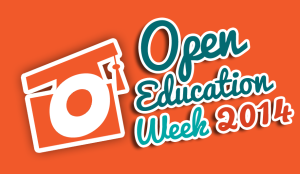At the recent Cetis conference – #cetis14 on twitter – Brian Kelly and I ran a session called “Open Knowledge: Wikipedia and Beyond”. The outcomes were much more interesting than might have been guessed – worthy of a post!
Wikipedia has culture, or cultures. I personally have little experience of them, simply from doing little edits, but was prodding around recently while researching for this session. Some Wikipedia culture seems very “geek” – with in jokes, perhaps putting off the uninitiated. Maybe this comes from much older newsgroup culture. People got to misunderstand each other much too frequently, and flame wars resulted. Rather harsh words like “mercilessly” still appear in the Wikipedia documentation, despite being debated extensively. They stand as a warning of the apparent harshness that may be felt, and also serve to put people off.
For example, there is an in joke, abbreviated to “TINC”, standing for “there is no cabal”. The article that explains this gives a good flavour of the culture it comes from and belongs in. I don’t think anyone would claim that this culture is a majority culture, and it is prone to excluding people. If we want Wikipedia to be a universal open educational resource, part of a proper “knowledge commons”, we must open this up.
An example that came up in our session was Wikipedia’s use of the term “editor”. Now many of us may assume that we all know that a Wikipedia “editor” is simply anyone who chooses to edit any article, but that awareness is not in fact a majority awareness. In the rest of the world, an “editor” has connotations of a book editor, or a newspaper editor – someone with a particular structured role. A Wikipedia “101” course needs to explain that right away. Or could the term be changed?
This links to an issue that was of wider relevance to the conference. What does “open” mean? Yes, there is the helpful open definition. But also, “open” is used in the phrase “open for business”, which is too frequently understood as meaning low on regulation, with few if any barriers preventing corporate money-making, even if that tramples over people and things that are important to them. The word “open”, like the word “freedom”, carries with it much ambivalence. What is open, to who, and why? Open for some may imply closed for others.
Just on the morning of our session I picked up two leads from tweets on related topics. Back in 2008, Michel Bauwens was asking Is something fundamentally wrong with Wikipedia governance process? In reply, P2P Lab pointed to a First Monday article from 2010 about Wikipedia’s peer governance. Then today I see reference to a more recent article on Wikipedia’s problems by Deepak Chopra. People are not unaware of problematic issues with Wikipedia.
One approach to dealing with the issues arising is simply to arrange more Wikipedia training. Brian is rightly keen on that. But it does raise the question, what can be trained, and what is more a matter of culture? Is it possible to help cultures that are good for open knowledge and its governance?
What peer governance cultures are there, anyway? I’ve had experience of consensus governance in a number of contexts, and there seem to be common problems. First, though most people are reasonable at collaboration, there are some who seem to act in ways that are indifferent to the common good, and only promote their own interests: takers, rather than givers, in Adam Grant’s scheme of humanity. The problem comes when takers are not dealt with effectively. Even in structures and organisations that are supposed to be managed by consensus, there seems to be a tendency to form cabals, or cliques: small elites who take over governance processes in their own interests (though sometimes they manage to fool themselves and others that they are trying to further the common interest).
Shouldn’t this be one of the roles of education, to bring people up, not only to further the common good, but to detect and deal with people who are not doing so?
Knowledge of what makes the common good, and collaborative skills (including communication and working with others) are clearly important, but seem not to be sufficient. We also need effective enculturation. Some kind of enculturation is at the heart of the hidden curriculum of educational institutions. Maybe it should be less hidden, and more transparent?
I won’t go on to detail possible solutions here, but in terms of where I am, I could easily envisage
- a framework for the competences, values or attitudes needed for effective peer-to-peer collaboration;
- a set of peer-assessed badges attesting these;
- related courses being set up as MOOCs;
- a whole lot of relevant open educational resources
and so on.
Back to the conference title: “Building the Digital Institution”. Is it, I ask, an institution that we want, in any recognisable form, complete with a hidden curriculum of a culture that is unlikely to be collaborative? Or is it a radically different kind of social organisation, built around, and promoting, a positive learners’ culture of learning through and for collaboration, peer-to-peer, co-operative in the best sense? Maybe our ideas, as well as our new technologies, can now help us make new efforts in the right direction. Let us not apply technology to entrenching elitism and privilege, but rather towards co-creating a knowledge commons that is truly open and transparent.
